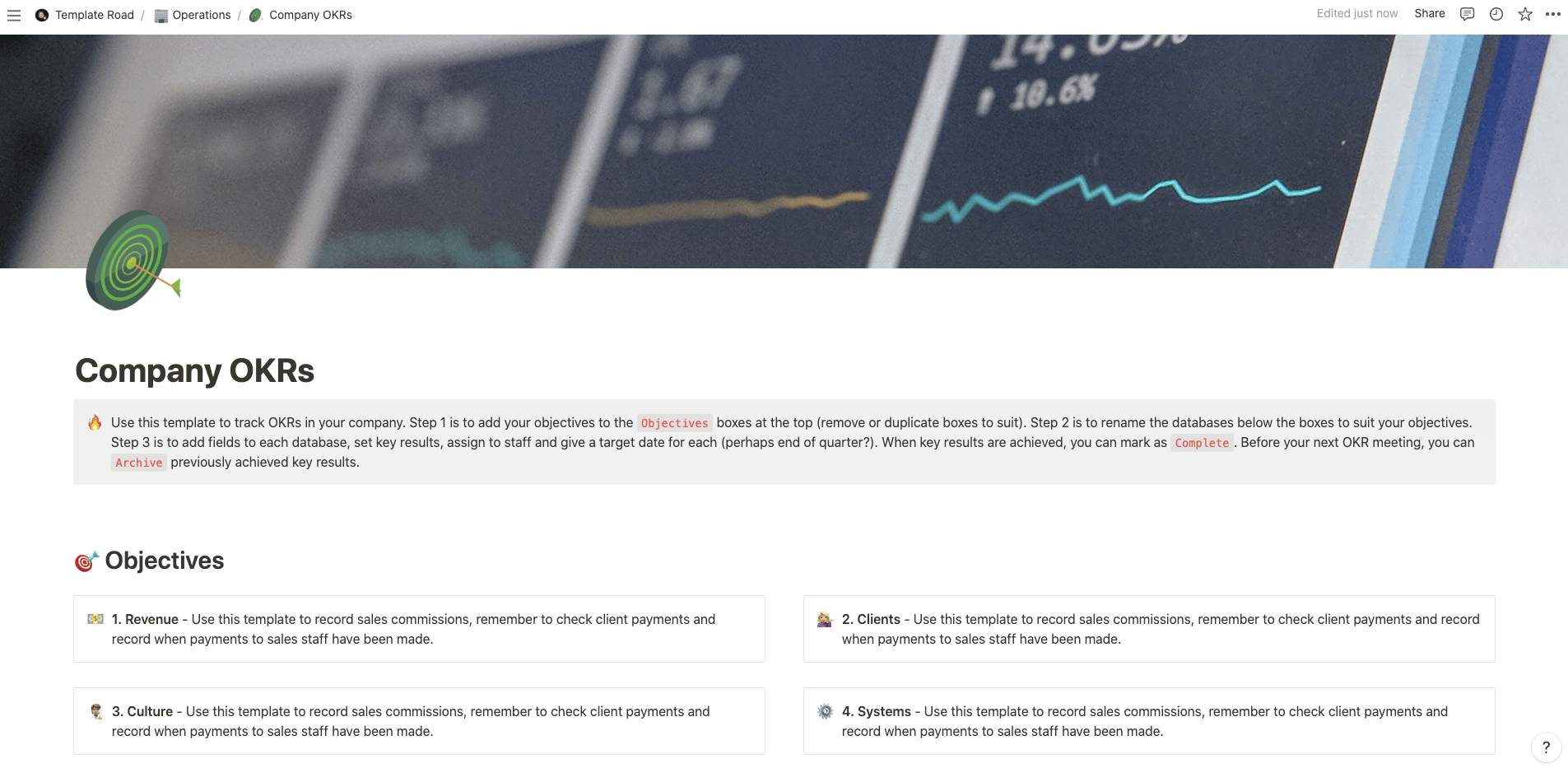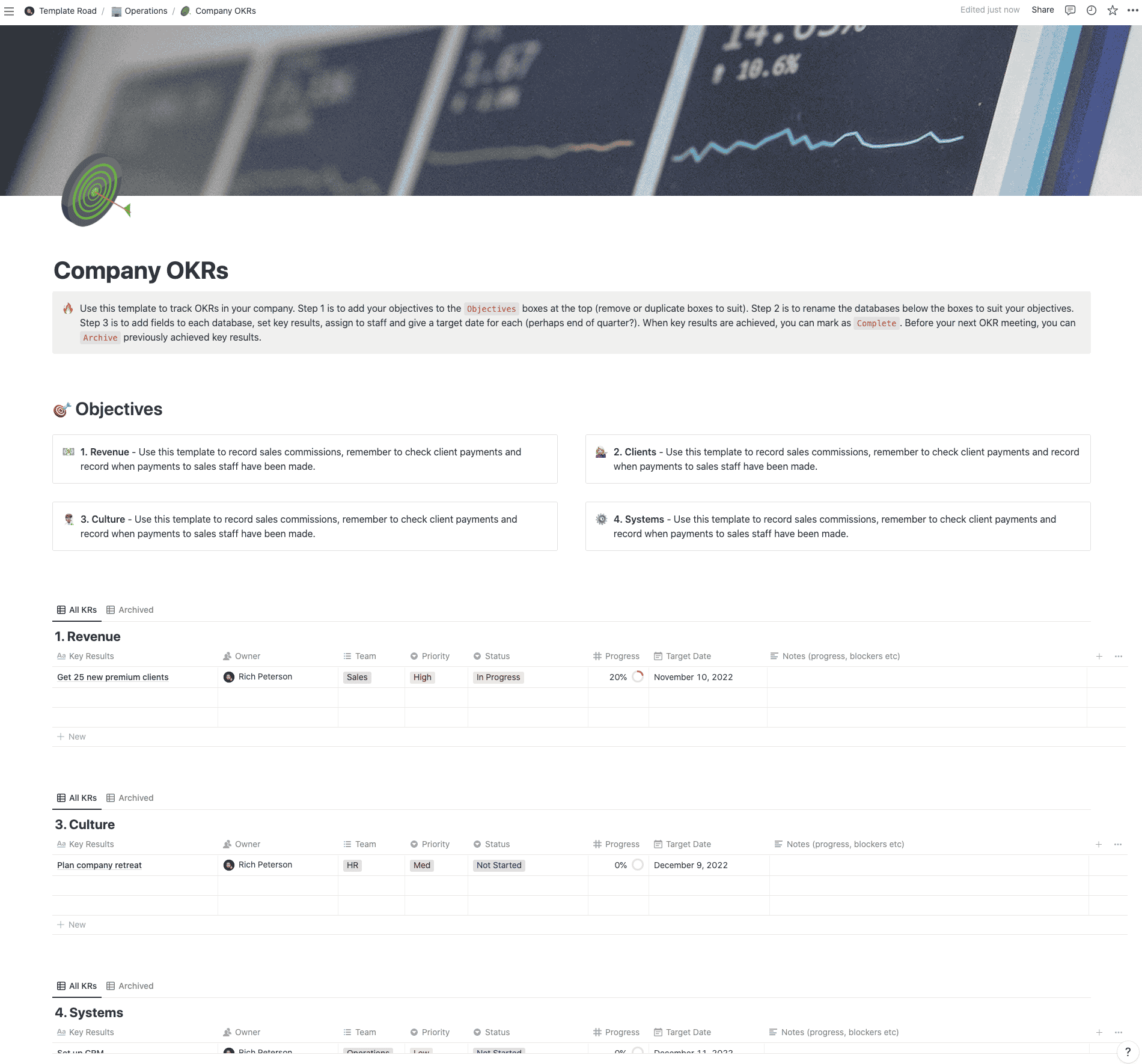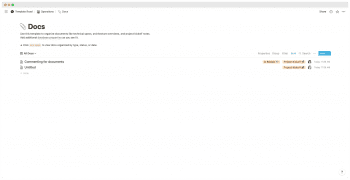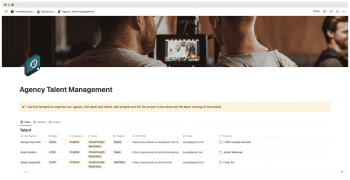When first transitioning to using OKRs, you can use this template to help break down the planning process by organizing the big picture (i.e., company aspirations and long-term goals), defining objectives and key results, and considering what factors might support or block efforts to achieve OKRs.
Contents
- Notion – Company OKRs Template
- What are OKRs?
- Why do we need OKRs?
- How do I create my own OKRs?
- OKR: Google’s approach to goal setting
- How are OKRs different from other goal-setting exercises? Are there upsides and downsides I should be aware of?
- What is the best way to communicate OKRs to my team?
- What are some tips for setting good objectives?
- How should I measure progress towards my OKRs?
- How often should I review my OKRs?
- How should I communicate changes to my OKRs?
Notion – Company OKRs Template
When first transitioning to using OKRs, you can use this template to help break down the planning process by organizing the big picture (i.e., company aspirations and long-term goals), defining objectives and key results, and considering what factors might support or block efforts to achieve OKRs.
This goal-setting process can help ensure that you’re prioritizing your OKRs appropriately and aligning them with your company vision. It can also help you to identify potential obstacles ahead of time and create more effective projects that serve your larger goals. Whether you want a first impression of what OKRs might look like at your organization or you are drilling down into specific details, this template is a flexible planning tool.
——————————————-
What you need before purchase
- Basic knowledge of how to use Notion
- Paid Notion account if you’re looking to add lots of content to your template / Notion account (sign up here). Not much content? You’re able to use their free account.
——————————————-
After purchase
After purchase, you’ll be able to view the template immediately. The template can be added to your Notion account by:
- Click on the template download link in Gumroad
- When viewing the Notion template, click on the “Duplicate” link in the top-right of your screen
- The template will now be available in your own Notion account
For ongoing use, the steps are:
- Login to Notion and select the template you want to view
- Click on the Duplicate link in the top-right of your screen to create a copy to use
- You’ll be able to retain the Notion template and work on the Duplicate (with a new name) and can repeat this process whenever you want to use the template again
What are OKRs?
OKR stands for Objectives and Key Results. It is a management tool that helps you to set goals, track progress towards those goals, and measure the results of your efforts. The concept was developed by Tom Peters in his book “In Search of Excellence”. He believed that setting clear objectives and tracking them against key performance indicators (KPI) would help companies achieve their business goals more effectively. The idea behind OKRs is simple: if you know what you want to accomplish, then it will be easier to figure out how to get there. If you don’t have an objective, you can’t possibly know whether or not you are on the right path.
Why do we need OKRs?
OKRs are used as a way to align everyone at work with the company’s strategy. They also provide a framework for measuring success and failure. This makes it easy to identify areas where improvement is needed.
How do I create my own OKRs?
You should start by defining your organization’s strategic direction. Then you should decide which metrics matter most to your organization. Finally, you should define your OKRs based on these metrics. Once you have defined your OKRs, you should share them with your team members so they understand why they were created and what they are meant to accomplish.
OKR: Google’s approach to goal setting
Google has been using OKRs since 2005. In fact, Google’s CEO Eric Schmidt wrote about this topic in his book “How Google Works”. Here are some interesting facts from his book:
Google uses three types of OKRs:
- Long term – 3 years
- Medium term – 1 year
- Short term – 6 months
Each employee sets one long-term, one medium-term and one short-term OKR.
Each OKR consists of two parts:
- Objective – What needs to happen
- Key Result – How much progress has been made toward achieving the objective
Employees use their OKRs to make decisions about what projects to take on next. Every quarter, employees review their OKRs and discuss any changes that may be necessary. At the end of each quarter, employees receive feedback on their OKRs. When an OKR isn’t working well, employees can change it. To ensure that all employees are aligned with the same vision, every new hire receives training on OKRs. Google encourages its managers to hold regular meetings to discuss OKRs. Managers who fail to meet their OKRs face consequences such as being demoted.
How are OKRs different from other goal-setting exercises? Are there upsides and downsides I should be aware of?
There are several advantages to using OKRs instead of traditional goal-setting methods. First, OKRs are less time-consuming than traditional goal-setting exercises because they require less planning. Second, they are more flexible than traditional goal-setting methods because they allow you to adapt them to fit your specific situation. Third, they encourage collaboration between teams. Fourth, they promote transparency among employees. Fifth, they give people ownership over their own goals. Sixth, they help managers focus on the big picture rather than getting bogged down in details.
However, there are also disadvantages to using OKRs. For example, they are difficult to implement across multiple locations. Also, they can be intimidating to employees who aren’t familiar with them.
What is the best way to communicate OKRs to my team?
The easiest way to get started is to ask your manager or HR representative to explain how OKRs work. You can then follow up with a meeting where you talk through the process together. If you don’t want to wait for someone else to do the explaining, you could create a presentation that explains OKRs to your team. You can find examples of presentations like this online. Another option would be to send out an email to your entire team explaining how OKRs work. This will help your team understand why they were created and how they might benefit them.
When communicating OKRs to your team, it’s important to keep these points in mind:
- Make sure everyone understands the purpose of the OKRs before starting.
- Explain how the OKRs will be used.
- Be clear about the expectations around the OKRs.
- Don’t expect your team members to read your mind.
- If you have questions about the OKRs, ask them.
- Keep track of the OKRs so that you know if they are working well.
- Encourage your team to provide feedback on the OKRs.
- Ask your team to suggest ways to improve the OKRs.
What are some tips for setting good objectives?
Here are some suggestions for creating effective OKRs:
- Start by identifying what success looks like for your organization.
- Write down the most important things that need to happen to achieve your organizational goals.
- Break down these goals into smaller pieces.
- Create SMART (specific, measurable, attainable, relevant, and timely) goals.
- Set deadlines for achieving your goals.
- Use “if/then” statements to make sure that you are focusing on the right outcomes.
- Include both short-term and long-term goals.
- Consider including subgoals within each objective.
- Think about whether you want to set individual goals or group goals.
- Be careful not to let your OKR become too broad.
- Try to include at least one objective per quarter.
How should I measure progress towards my OKRs?
OKRs are meant to be measured periodically throughout the year. The frequency depends on the type of OKR you are tracking. Here are some guidelines:
- Quarterly OKRs – These OKRs should be tracked every three months. They should cover a period of six months.
- Annual OKRs – These OKRs should be tracked annually. They should cover a 12-month period.
- Monthly OKRs – These OKRS should be tracked monthly. They should cover a 6-month period.
- Weekly OKRs – These OKRs should be tracked weekly. They should cover a 3-month period.
- Daily OKRs – These OKRs should be tracked daily. They should cover a 1-week period.
How often should I review my OKRs?
You should review your OKRs regularly. It’s a good idea to review them once a quarter. However, you may also want to review them more frequently depending on the size of your team and the complexity of your OKRs. You can use any method you prefer to track your OKRs. Some people like to write their OKRs down on sticky notes and put them somewhere visible. Others prefer to use software like Notion, using the template above.
How should I communicate changes to my OKRs?
If you decide to change your OKRs, you should communicate this to your team. You could do this via email, phone calls, or even face-to-face meetings. It is important to explain why you made the changes and how they will affect your team. Also, be sure to tell your team when you plan to reevaluate the OKRs.
















